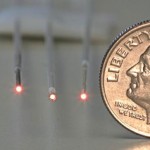 Emergency workers could be warned by a new kind of microsensor when carbon filter become dangerously saturated. In fact, on the ends of optical fibers are mounted porous photonic crystal particles as microsensors.
Emergency workers could be warned by a new kind of microsensor when carbon filter become dangerously saturated. In fact, on the ends of optical fibers are mounted porous photonic crystal particles as microsensors.
A team of scientist from the University of California, San Diego and Tyco Electronics recently described in the journal of Advanced Materials, how they made the carbon nanostructures to demonstrate their use as microsensors for volatile organic compounds.
“The new microsensors would provide a more accurate reading of how much material the carbon in the filters has actually absorbed,” said team leader Michael Sailor, professor of chemistry and biochemistry and bioengineering at UC San Diego. “Because these carbon nanofibers have the same chemical properties as the activated charcoal used in respirators, they have a similar ability to absorb organic pollutants.”
The Sailor’s team organized the nanofibers into repeating structures called photonic crystals in order to reflect specific wavelengths, or colors of light. An example for this kind of structure is the coloring of wing scales of the Morpho butterfly, which gives the insect its brilliant iridescent coloration.
The microsensors are an iridescent color thing, rather than black like ordinary carbon. When the nanofibers absorb toxins the color is changing as visible indicators of their capacity to absorb additional chemicals.
The National Institute of Occupational Safety and Health, has long sought microsensors with design requirements for tiny, sensitive, inexpensive device that requires little power, but have proved difficult to meet.
Sailor’s group has previously placed similar photonic sensors on the tips of optical fibers less than a millimeter across and shown that they can be inserted into respirator cartridges.
The materials that now the team has fabricated are very thin – less than half the diameter of a human hair and the crystals are sensitive enough to detect chemicals such as toluene at concentrations as low as one part per million.



